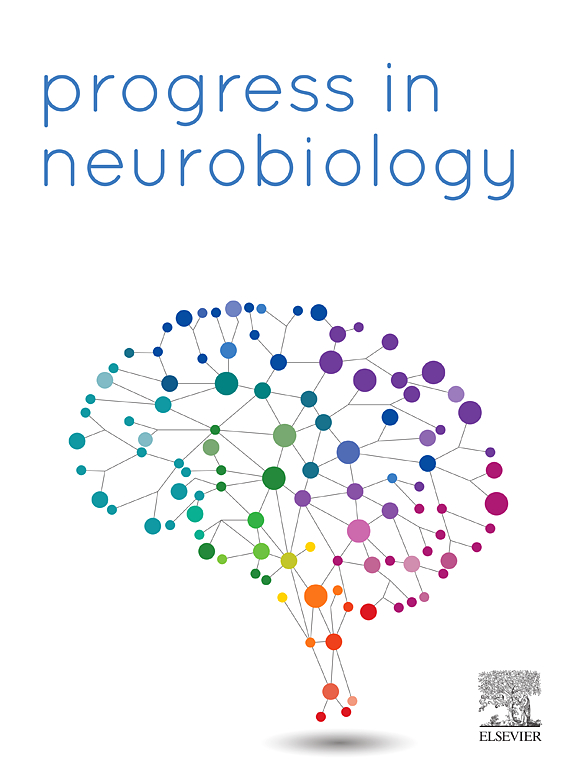致病性寡聚Tau通过与RNA结合蛋白Musashi1形成核异聚淀粉样蛋白改变神经元RNA过程。
IF 6.1
2区 医学
Q1 NEUROSCIENCES
引用次数: 0
摘要
阿尔茨海默病(AD)的特征是细胞质蛋白病变,主要涉及错误折叠的Tau蛋白。致病性Tau蛋白,如可溶性低聚物和原纤维,会破坏RNA代谢,但其机制尚不清楚。最近的研究表明,RNA在Tau聚集中起着至关重要的作用。我们的研究建立在此基础上,注意到AD和额颞叶痴呆(FTLD)大脑中rna结合蛋白(rbp)与Tau蛋白的显著共沉积。利用分子和细胞技术,我们研究了RNA动力学和Tau聚集之间的相互作用,重点研究了Tau和rbp,特别是Musashi (MSI)在神经元核内的定位和聚集。通过细胞荧光、生化和细胞分析,我们揭示了Tau/RBP相互作用在表达野生型和突变型Tau的初级皮质神经元中的重要性。致病性Tau寡聚物改变MSI蛋白的定位和功能,引起细胞质和细胞核聚集。Tau模型中MSI1核相互作用体的质谱分析显示,RNA代谢途径被破坏,包括核糖体生物发生、RNA剪接和蛋白质折叠。此外,RNA免疫沉淀实验显示突变体P301L Tau对MSI1结合RNA靶点的能力有显著影响。这些发现突出了早期神经退行性治疗干预的潜在目标。本文章由计算机程序翻译,如有差异,请以英文原文为准。
Pathogenic oligomeric Tau alters neuronal RNA processes through the formation of nuclear heteromeric amyloids with RNA-binding protein Musashi1
Alzheimer’s disease (AD) is marked by cytoplasmic proteinopathies, primarily involving misfolded Tau protein. Pathogenic Tau species, such as soluble oligomers and fibrils, disrupt RNA metabolism, though the mechanisms are unclear. Recent research indicates that RNA has a crucial role in Tau aggregation. Our study builds on this by noting significant co-deposition of RNA-Binding Proteins (RBPs) with Tau in AD and Frontotemporal dementia (FTLD) brains. Using molecular and cellular techniques, we investigate the interaction between RNA dynamics and Tau aggregation, focusing on the localization and aggregation of Tau and RBPs, particularly Musashi (MSI), within neuronal nuclei. Through cyto-fluorometric, biochemical, and cellular assays, we reveal the importance of Tau/RBP interplay in primary cortical neurons expressing wild-type and mutant Tau. Pathogenic Tau oligomers alter MSI protein localization and function, causing cytoplasmic and nuclear aggregation. Mass spectrometry of the MSI1 nuclear interactome in Tau models shows disrupted RNA metabolism pathways, including ribosomal biogenesis, RNA splicing, and protein folding. Moreover, RNA immunoprecipitation assay revealed a remarkable impact of mutant P301L Tau on MSI1 ability to bind RNA targets. These findings highlight potential targets for early neurodegenerative therapeutic interventions.
求助全文
通过发布文献求助,成功后即可免费获取论文全文。
去求助
来源期刊

Progress in Neurobiology
医学-神经科学
CiteScore
12.80
自引率
1.50%
发文量
107
审稿时长
33 days
期刊介绍:
Progress in Neurobiology is an international journal that publishes groundbreaking original research, comprehensive review articles and opinion pieces written by leading researchers. The journal welcomes contributions from the broad field of neuroscience that apply neurophysiological, biochemical, pharmacological, molecular biological, anatomical, computational and behavioral analyses to problems of molecular, cellular, developmental, systems, and clinical neuroscience.
 求助内容:
求助内容: 应助结果提醒方式:
应助结果提醒方式:


